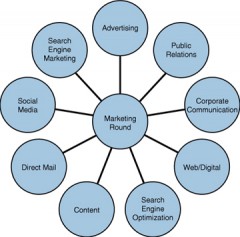I’m sure you see or hear this a lot: Traditional PR is dead! Media relations is dead! Websites are dead! Marketing is dead! Advertising is dead! Newspapers are dead!
Granted, sometimes those things are written to motivate people to click on a link, but all of the customary ways of communication are far from dead. Instead, we find it’s necessary to integrate the things that are “dead” with digital public relations.
Integrated marketing communications isn’t new. In the late 90s and early 00s, lots of organizations were finding ways to break down internal silos and inspire departments to work together. Dell asked WPP to consolidate all of its agencies under one roof and you saw traditional ad agencies bringing in PR, PR agencies bringing in graphic designers, and web firms finding ways to work with PR and advertising.
Integration vs. Silos
Then, of course, the tech bubble burst, 9/11 enveloped the world, and the United States faced the Great Recession. Because of that and our unemployment rate skyrocketing, people wanted to protect their jobs. They went back to what they knew and, in most cases, re-created silos inside organizations.
But here we are, facing a world where technology comes at us so quickly now, it’s impossible to keep up, and if we don’t figure out – quickly – how to integrate and work with other departments, we’ll be left behind.
Think about it this way: It used to be you’d have a crisis communication plan written and it would stay in a drawer until your PR team pulled it out the following year, dusted it off, and gave it a good rewrite. Now a crisis can erupt online in about 20 minutes if you have one angry employee or customer.
Customer service used to be kept to the people in the cube farms who answered the phones all day. Now the PR or marketing professionals are managing customer service and experience through the social networks.
And media relations meant you built relationships with journalists who stayed in the same job for years and years and years. Now influencers are bloggers, customers with large Twitter followings, or employees who have highly engaged online friends.
Integrated Marketing Communications
The value of integrated marketing communications and of departments working together cohesively is more important now than it ever has been in our history.
Following are five tips to integrate your efforts with those in other departments.
- Lobby your senior executives to make total integration part of the incentive program for every employee. One of the things Geoff Livingston and I talk about in Marketing in the Round is how to do that efficiently and effectively.
- Develop an internal team – made up of one person from every department – to lead the charge and to be sure everyone knows what the other is doing. If your organization is small, it’s easier to do this, but don’t think you don’t have silos. When you have more than three people working together, silos exist.
- Customer service and HR (if they’re not already) will begin to use the social networks to connect with the people PR professionals have been building relationships with for the past few years. These are the people who work with your organization: They buy from you, they support you, or they work with you. It’s imperative these people have different touchpoints within the organization. Help them help you.
- Work with your colleagues on all facets of the organization’s growth. No longer can product development launch something without marketing and marketing can’t do a promotion or event without customer service.
- Create a system for complete transparency so people move out of their comfort boxes and are willing to work together, instead of in their silos.
In some ways, this is change management and, in others, you’re going to be asking senior leadership to do something out of the norm.
It’s easy to say, “Oh. I’m in PR. I don’t need to do this.” But someone needs to do it and, as communicators, it’s our jobs to make sure customers and employees are getting what they need.
Why not lead this charge, as well?
P.S. We’re just a little more than a week away from our free webinar with email marketing genius, DJ Waldow. Join us on Thursday, July 25 at 11 a.m. CT. Register by clicking here.
